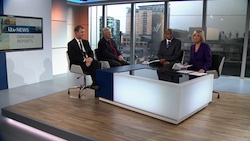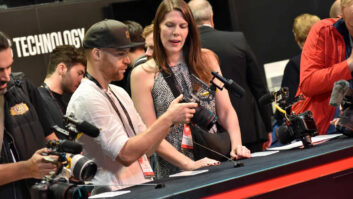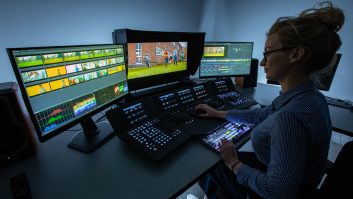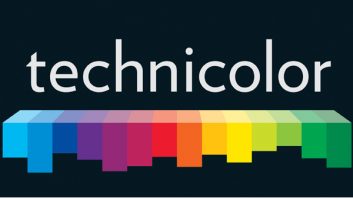
ITV Granada is moving its operation from its home for over 50 years in Quay Street to Media City in Salford Quays– taking occupancy of three floors in the ‘Orange’ building, as well as creating a brand-new dedicated Coronation Street green-field build production operation. By Paul Stevenson, director of Technical Operations for ITV News.
The regional news operation has now moved across to the Orange building, using a 4th floor outlook over distinctive landmarks to provide a live backdrop for the service, which launched on 25 March, after a comprehensive site fit-out and technical build.
Media City is a showcase for all broadcasters operating there, and ITV wanted its regional news service to be a visible part of our operation, showcasing the news presentation and taking advantage of the landmark views visible from our location. Rather than separate the different ITV business areas within the new site, we have co-sited and brought together our activities, sharing space and amenities, with common working areas. So the challenge was to a build a facility for news that shared space with ITV’s wider activities, and deliver a visible presence for the news operation.
In addition, we were to invest in completely updated news production technology, naturally becoming a fully HD regional news operation in the process, with a complete solid-state acquisition and file-based production process.
A glass view
To achieve the look, we built our ‘glass box’ studio. As the name suggests, this is a studio with glass walls, able to shoot in three directions; into our newsroom, our glass-fronted gallery, and critically using the exterior backdrop of the Salford landscape – with the distinctive Lowry gallery and War Museum being the showcase features.
Shooting through glass is never straightforward, and there are so many variables to conside; the light intensity outside, the light inside (that’s the bit that’s easy to control), as well as colour temperatures – outside, inside and the in-vision monitors. At the heart of the solution there needs to be a mechanism for controlling the light coming in through the glass. This was an area we researched and tested a lot – there are different ways of doing this, but we finally settled on a polarising–based solution from Rosco.
The principal is simple enough; cover the windows with a polarising filter and equip all studio cameras with rotating, remote-controlled polarising filters. Turning these filters selectively attenuates the polarised light coming through the glass, independently of the studio lighting. We coupled that with a fully LED-based lighting grid.
There were some unforeseen outcomes, for instance that LCD monitors use polarisers, which are affected by the system – so no good for our large on-screen displays. Plasmas were needed for that.
Despite rigorous planning and testing, the result isn’t really known until the ‘switch it all on’ moment, when all the elements are brought together. The unanimous view is that is looks great, and the more careful adjustments we make with cameras, lights and the polarisers, the better it looks.
The sun set halfway through our first night magazine news programme. Instead of that being a problem, it simply added to the dynamic effect. It’s been a steep learning curve, and one that we’re still on; sometimes balancing all the lighting considerations feels a bit like juggling while standing on a ball, but we are hugely pleased with the results. We’ve got an established pattern of working now, and the look we aimed to achieve
Newsroom departure
We replaced our Avid Unity-based systems and DVCAM cameras with an all-new Avid ISIS-based system and a Sony XDCAM solid-state workflow. So all our tape decks are (nearly) gone.
Within ITV News, our on-screen journalists self-shoot and edit, and we replaced all out ‘fleet’ of DVCAMs and EX1 cameras at ITV Granada with PMW 200s for journalists and PMW 500s for our camera crews.
The new generation of the Avid newsroom solution is quite a departure. As well as providing familiar desktop editing, scripting, media storage and playout facilities, we are getting to grips with the opportunities around Interplay Central, Avid’s web-based editing/ iNews solution (along with Sphere, their client-based remote working tool).
We have replaced our LAN Share shared storage server in Liverpool with a Sphere client – so now media is ingested locally, stored on our ISIS server in Salford and remote-edited and accessed via Sphere and viewed via proxies. That’s an early test for the Sphere workflow. Remote and simplified working is at the heart of our regional news production strategy.
ITV regional news has also invested in a Chyron-based on-air graphics production system. We have built a centralised graphics ‘hub’ in our Birmingham operation, where our team of designers produces templates and graphics content for our news regions. On-screen graphics are produced by populating templates by journalists, and played out live from the gallery, or incorporated into edited packages. ITV Granada went first with the new Chyron-based system, and our other regions are now following. TSL provided the systems integration for the project.
So, a lot of new technologies and changes on one opening night – but we are very pleased with the results. But choosing the equipment is only a part of delivering success; the key is in planning, installation and integration into building processes, plus a total thoroughness in fine-tuning and testing the design and configuration to create a solution that works for users — as well as engineers.
The attention to detail in testing, rehearsing, workflow development and training, building up to the launch, was critical. The collaboration between suppliers, operational, editorial and technical colleagues within news and around ITV — and the huge level of effort and commitment applied — has delivered a great result for us.






